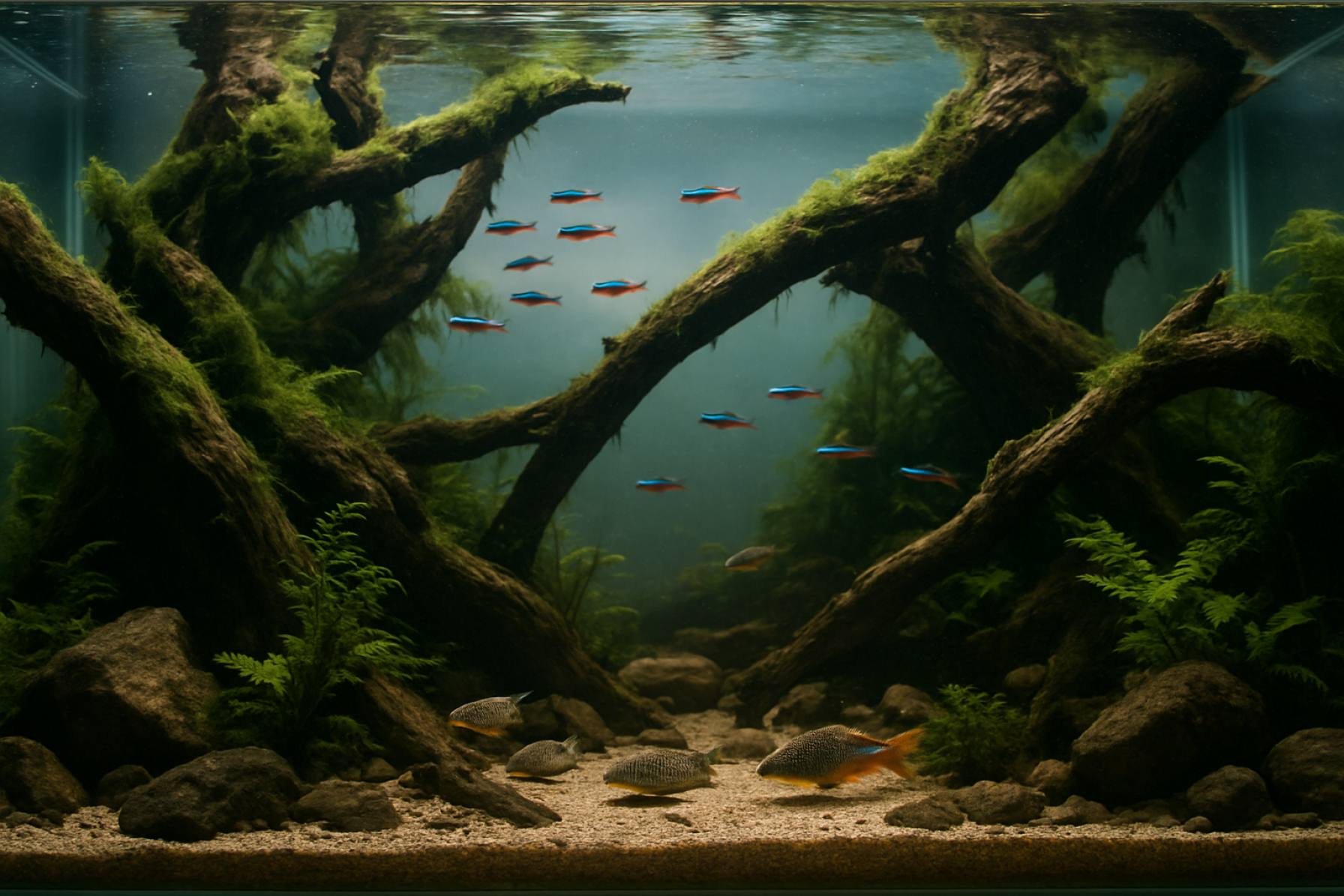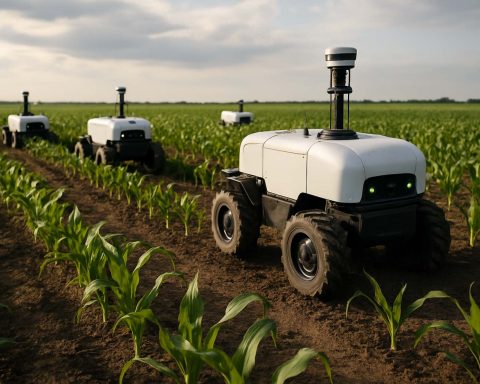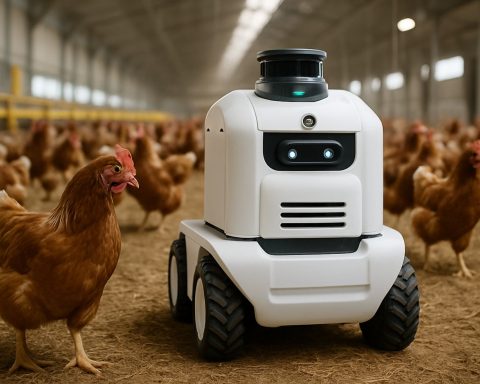Inside Aquascaping Biotope Competitions: How Precision, Creativity, and Ecology Collide in the World’s Most Authentic Aquarium Challenges. Discover What Sets These Events Apart and Why They’re Captivating Aquarists Worldwide. (2025)
- Introduction: What Are Aquascaping Biotope Competitions?
- History and Evolution of Biotope Aquascaping Events
- Key Rules and Judging Criteria: Authenticity, Ecology, and Aesthetics
- Major Global Competitions and Organizing Bodies
- Techniques and Tools: Recreating Natural Habitats
- Role of Conservation and Education in Biotope Aquascaping
- Profiles of Award-Winning Biotope Aquascapes
- Technology’s Impact: Digital Tools, Lighting, and Filtration Advances
- Market Trends and Public Interest: Growth, Participation, and Forecasts
- Future Outlook: Sustainability, Innovation, and the Next Generation of Biotope Competitions
- Sources & References
Introduction: What Are Aquascaping Biotope Competitions?
Aquascaping biotope competitions are specialized events where participants design and construct aquatic environments that authentically replicate specific natural habitats, known as biotopes. Unlike general aquascaping contests that emphasize artistic expression and creativity, biotope competitions focus on scientific accuracy, ecological fidelity, and the faithful representation of real-world aquatic ecosystems. Entrants are judged on their ability to mimic the physical, chemical, and biological parameters of a chosen habitat, including the selection of flora, fauna, substrate, water chemistry, and even the microhabitat’s seasonal characteristics.
These competitions have gained significant traction in the global aquascaping community, particularly over the past decade. The rise of international events such as the Biotope Aquarium Design Contest—organized by the Biotope Aquarium Project, a leading authority in biotope aquascaping—has set rigorous standards for authenticity and educational value. The contest attracts participants from over 50 countries, with entries evaluated by panels of ichthyologists, botanists, and experienced aquarists. Other notable organizations, such as the Aquatic Gardeners Association, have also incorporated biotope categories into their annual competitions, further legitimizing the discipline.
The core objective of these competitions is not only to celebrate aesthetic achievement but also to promote conservation awareness and scientific literacy. By encouraging hobbyists to research and recreate threatened or lesser-known habitats, biotope contests foster a deeper understanding of aquatic biodiversity and the environmental challenges facing freshwater and marine ecosystems. In recent years, there has been a marked increase in entries focusing on endangered biotopes, reflecting a growing alignment with global conservation priorities.
Looking ahead to 2025 and beyond, the outlook for aquascaping biotope competitions is robust. Organizers are expanding digital participation, enabling remote judging and virtual exhibitions to accommodate a broader international audience. There is also a trend toward collaboration with scientific institutions and conservation NGOs, aiming to use these competitions as platforms for citizen science and habitat advocacy. As the field matures, the integration of advanced water testing, 3D habitat mapping, and educational outreach is expected to further elevate the scientific rigor and impact of biotope aquascaping events.
History and Evolution of Biotope Aquascaping Events
Biotope aquascaping competitions have evolved significantly since their inception, reflecting both the growing sophistication of the aquascaping community and a heightened emphasis on ecological authenticity. The earliest formalized biotope competitions emerged in the late 2000s, as aquarists sought to move beyond aesthetic layouts and instead recreate specific natural habitats with scientific accuracy. This approach required participants to research and replicate the physical, chemical, and biological parameters of real-world aquatic ecosystems, including native flora, fauna, and substrate types.
A pivotal moment in the history of biotope aquascaping was the establishment of the Biotope Aquarium Design Contest (BADC), organized by the Biotope Aquarium Project. Since its launch, the BADC has become a global benchmark, attracting hundreds of entries annually from over 50 countries. The contest’s rigorous judging criteria—focusing on ecological fidelity, educational value, and conservation awareness—have set standards that other competitions now emulate. The BADC’s influence is evident in the proliferation of regional and national biotope contests, particularly in Europe, Asia, and South America.
In recent years, major international aquascaping events such as the International Aquatic Plants Layout Contest (IAPLC), organized by Aqua Design Amano, have incorporated dedicated biotope categories, further legitimizing the discipline. The IAPLC, widely regarded as the world’s largest aquascaping competition, has reported a steady increase in biotope entries, reflecting a broader trend toward ecological themes and conservation messaging within the hobby.
The evolution of biotope competitions has also been shaped by advances in digital technology. Online platforms now enable global participation, virtual judging, and real-time feedback, making these events more accessible and transparent. The Biotope Aquarium Project has pioneered digital submission formats and interactive educational resources, fostering a more inclusive and informed community.
Looking ahead to 2025 and beyond, the outlook for biotope aquascaping competitions is robust. Organizers are expected to place greater emphasis on conservation partnerships, citizen science, and public outreach. There is a growing movement to use biotope competitions as platforms for raising awareness about threatened habitats and species, with collaborations emerging between aquascaping organizations and conservation NGOs. As environmental concerns intensify globally, biotope aquascaping is poised to play an increasingly prominent role in both the aquarium hobby and broader ecological education.
Key Rules and Judging Criteria: Authenticity, Ecology, and Aesthetics
Aquascaping biotope competitions have gained significant prominence in recent years, with 2025 expected to see further refinement of judging standards and increased global participation. These competitions challenge aquascapers to recreate authentic aquatic habitats, emphasizing not only visual appeal but also ecological accuracy and sustainability. The key rules and judging criteria are typically structured around three pillars: authenticity, ecology, and aesthetics.
Authenticity is the cornerstone of biotope aquascaping competitions. Participants are required to meticulously research and replicate a specific natural aquatic environment, such as a section of the Amazon River or an African rift lake. Judges assess the accuracy of species selection—both flora and fauna—substrate composition, water parameters, and even the arrangement of hardscape materials. Leading competitions, such as the Biotope Aquarium Design Contest and the International Aquatic Plants Layout Contest (IAPLC), provide detailed guidelines on acceptable biotope documentation, including scientific references and photographic evidence of the original habitat.
Ecology is increasingly emphasized as environmental awareness grows within the aquascaping community. In 2025, competitions are expected to further prioritize ecological balance, requiring entrants to demonstrate that their setups support the natural behaviors and well-being of the chosen species. This includes appropriate water chemistry, temperature, and flow, as well as the provision of hiding places and breeding sites. Some events, such as those organized by the Biotope Aquarium Design Contest, now require a written ecological rationale, explaining how the aquascape mimics the nutrient cycles and interspecies interactions found in the wild.
Aesthetics remain a vital judging criterion, though in biotope competitions, beauty is measured by how faithfully the aquascape captures the essence of the natural habitat. Judges look for naturalistic composition, harmonious color schemes, and the overall impression of an untouched ecosystem. Unlike traditional aquascaping contests, where artistic interpretation is encouraged, biotope events reward restraint and scientific accuracy. The International Aquatic Plants Layout Contest and similar organizations have updated their scoring rubrics to reflect this balance between visual impact and authenticity.
Looking ahead, the outlook for biotope aquascaping competitions in 2025 and beyond points to even stricter adherence to scientific standards, with greater involvement from ichthyologists and ecologists in the judging process. Digital platforms and virtual submissions are also expected to expand, making these events more accessible to a global audience and further raising the bar for authenticity, ecological soundness, and aesthetic fidelity.
Major Global Competitions and Organizing Bodies
Aquascaping biotope competitions have gained significant prominence in recent years, reflecting a growing global interest in ecological authenticity and conservation within the aquarium hobby. These competitions challenge participants to recreate natural aquatic habitats as accurately as possible, using species and materials native to specific geographic regions. The trend is expected to continue into 2025 and beyond, with several major events and organizations shaping the landscape.
One of the most influential bodies in this field is the Biotope Aquarium Design Contest (BADC), organized annually since 2011. The BADC is recognized for its rigorous standards and international reach, attracting hundreds of entries from over 50 countries. The contest emphasizes scientific accuracy, environmental education, and the promotion of biotope conservation. In 2024, the BADC reported a record number of entries, and early indicators suggest continued growth for the 2025 edition, with expanded categories and increased participation from Asia and South America.
Another key player is the International Aquatic Plants Layout Contest (IAPLC), organized by Aqua Design Amano Co., Ltd. While the IAPLC is primarily known for its artistic aquascaping competitions, it has increasingly incorporated biotope-specific categories and criteria, reflecting the hobby’s shift toward ecological authenticity. The IAPLC’s global platform and extensive judging panel, which includes leading aquascapers and biologists, have helped elevate the profile of biotope aquascaping worldwide.
Regional organizations are also contributing to the growth of biotope competitions. The European Aquatic Plants Layout Contest (EAPLC) and the Aquatic Gardeners Association (AGA) in North America both host annual events with dedicated biotope categories. These competitions often collaborate with scientific institutions and conservation groups to ensure accuracy and promote awareness of threatened habitats.
Looking ahead to 2025 and the following years, the outlook for aquascaping biotope competitions is robust. Organizers are increasingly leveraging digital platforms for virtual submissions and judging, broadening access and participation. There is also a growing emphasis on educational outreach, with workshops, webinars, and partnerships with conservation organizations. As environmental concerns and biodiversity conservation become more central to the aquarium hobby, biotope competitions are expected to play a pivotal role in shaping best practices and inspiring a new generation of aquascapers.
Techniques and Tools: Recreating Natural Habitats
Aquascaping biotope competitions have gained significant momentum in recent years, with a growing emphasis on accurately recreating natural aquatic habitats using advanced techniques and specialized tools. As of 2025, these competitions are increasingly recognized for their educational value and their role in promoting biodiversity awareness among aquarists and the broader public.
A biotope aquascape aims to replicate a specific natural environment, including its flora, fauna, water parameters, and even microhabitats. Leading competitions, such as the Biotope Aquarium Design Contest (BADC), organized by Biotope Aquarium Project, and the biotope category of the International Aquatic Plants Layout Contest (IAPLC), have set rigorous standards for authenticity and ecological accuracy. Participants are required to provide detailed documentation, including scientific references, photographs of the original habitat, and water chemistry data, to support their design choices.
Recent years have seen a surge in the use of digital tools and databases to aid in habitat research and planning. Platforms like the Biotope Aquarium Project offer extensive biotope databases, species lists, and habitat maps, enabling competitors to access up-to-date ecological information. These resources help aquascapers select regionally accurate plant and animal species, substrate types, and hardscape materials, ensuring a faithful recreation of the chosen ecosystem.
Technological advancements have also influenced the tools used in biotope aquascaping. High-precision water testing kits, programmable LED lighting systems that mimic natural photoperiods, and advanced filtration technologies are now standard in top-tier competitions. These tools allow for the fine-tuning of water parameters such as pH, hardness, and temperature, which are critical for maintaining the health of sensitive species and achieving a true-to-nature display.
Looking ahead to the next few years, the outlook for biotope competitions is marked by increasing collaboration with scientific institutions and conservation organizations. There is a growing trend toward using competitions as platforms for citizen science, with participants contributing data on species distributions and habitat conditions. This aligns with the missions of organizations like the International Union for Conservation of Nature (IUCN), which advocates for the preservation of aquatic biodiversity. As environmental awareness continues to rise, biotope aquascaping is expected to play an even greater role in education, conservation, and the responsible enjoyment of the aquarium hobby.
Role of Conservation and Education in Biotope Aquascaping
Biotope aquascaping competitions have increasingly positioned themselves at the intersection of conservation and education, reflecting a broader shift in the aquascaping community toward ecological responsibility and public awareness. These competitions, which challenge participants to recreate authentic aquatic habitats using only species and materials native to a specific region, serve as powerful platforms for promoting biodiversity, habitat preservation, and environmental stewardship.
In 2025, leading international events such as the International Aquatic Plants Layout Contest (IAPLC) and the Aquatic Gardeners Association’s annual competitions continue to feature dedicated biotope categories. These categories are judged not only on aesthetic merit but also on ecological accuracy and the educational value of the display. The Biotope Aquarium Project, a global initiative, has further formalized biotope competitions by providing standardized guidelines and a comprehensive database of natural habitats, which participants and judges use to ensure scientific fidelity.
A key trend in 2025 is the explicit integration of conservation messaging into competition frameworks. Organizers increasingly collaborate with conservation organizations and scientific bodies to highlight the threats facing natural aquatic ecosystems, such as habitat loss, invasive species, and climate change. For example, the IAPLC and Biotope Aquarium Project have both partnered with freshwater conservation groups to provide educational seminars, workshops, and online resources alongside their competitions. These efforts aim to inspire hobbyists and the public to support conservation initiatives and adopt sustainable practices in their own aquariums.
Educational outreach is also expanding through digital platforms. Virtual tours, interactive judging panels, and live-streamed presentations allow a global audience to engage with biotope aquascaping, learn about the ecological significance of different habitats, and understand the importance of species-specific care. The Aquatic Gardeners Association and the Biotope Aquarium Project both maintain extensive online archives of past entries, complete with scientific commentary and habitat data, serving as valuable resources for educators, students, and hobbyists.
Looking ahead, the outlook for biotope aquascaping competitions is one of continued growth and deepening impact. As environmental concerns become more urgent, these events are expected to play an even greater role in conservation advocacy and public education, fostering a new generation of aquarists who are not only artists but also stewards of aquatic biodiversity.
Profiles of Award-Winning Biotope Aquascapes
Biotope aquascaping competitions have gained significant prominence in recent years, with a growing emphasis on ecological accuracy, conservation awareness, and artistic representation of natural aquatic habitats. These events challenge aquascapers to recreate authentic biotopes—specific aquatic environments that mimic the flora, fauna, and physical characteristics of real-world locations. The profiles of award-winning biotope aquascapes from 2025 and the preceding years reflect both technical mastery and a deep understanding of ecological systems.
One of the most influential competitions is the Biotope Aquarium Design Contest (BADC), organized annually by Biotope Aquarium Project. The 2024 and 2025 editions have seen a surge in entries from over 50 countries, with participants meticulously researching and replicating habitats such as the Rio Negro floodplains, Southeast Asian peat swamps, and African rift lakes. Winning entries are evaluated on criteria including biotope accuracy, species selection, aquascape aesthetics, and educational value. For example, the 2024 Grand Prix winner recreated a flooded Amazonian igapó forest, using authentic driftwood, leaf litter, and region-specific fish and invertebrates, earning praise for both visual impact and ecological fidelity.
The Aquatic Gardeners Association (AGA), a leading international non-profit dedicated to aquatic gardening, also hosts a biotope category in its annual International Aquascaping Contest. Recent top entries have included detailed representations of Lake Tanganyika’s rocky shorelines and the slow-moving blackwater streams of Borneo. These aquascapes are often accompanied by comprehensive documentation, including water parameters, species lists, and references to scientific literature, underscoring the educational mission of the event.
In Europe, the European Aquatic Plants Layout Contest (EAPLC) has expanded its biotope section, attracting both hobbyists and professional aquascapers. The 2025 competition is expected to highlight innovative approaches to sustainable aquascaping, such as the use of locally sourced materials and captive-bred species, reflecting a broader trend toward environmental responsibility in the hobby.
Looking ahead, biotope aquascaping competitions are poised to further integrate conservation themes, with organizers collaborating with scientific institutions and conservation NGOs to promote habitat preservation. The increasing availability of digital resources and global networking platforms is expected to raise the standard of entries and foster a more diverse, informed community of aquascapers worldwide.
Technology’s Impact: Digital Tools, Lighting, and Filtration Advances
Aquascaping biotope competitions have increasingly embraced technological advancements, fundamentally transforming both the creative process and the standards of judging. As of 2025, digital tools, lighting innovations, and filtration systems are at the forefront of this evolution, enabling participants to achieve unprecedented levels of ecological accuracy and aesthetic refinement.
Digital design platforms and 3D modeling software now play a pivotal role in the planning stages of biotope aquascapes. Competitors utilize these tools to simulate layouts, test plant and hardscape arrangements, and visualize water flow dynamics before any physical setup begins. This not only streamlines the creative process but also allows for precise replication of natural habitats, a key criterion in biotope competitions. Leading organizations such as the International Aquatic Plants Layout Contest (IAPLC) and the Biotope Aquarium Design Contest have acknowledged the growing use of such technologies among top entrants, with some even encouraging digital submissions for preliminary rounds.
Lighting technology has also seen significant advancements, with full-spectrum LED systems now standard in high-level competitions. These systems offer customizable spectrums and intensities, closely mimicking the natural light conditions of specific biotopes. Programmable lighting schedules can replicate sunrise, sunset, and seasonal variations, supporting both plant health and the behavioral rhythms of aquatic fauna. The Aquatic Gardeners Association, a prominent body in the aquascaping community, has highlighted the role of advanced lighting in achieving authentic biotope recreations and in supporting the welfare of sensitive species.
Filtration technology has likewise advanced, with modern canister and sump filters offering modularity, energy efficiency, and enhanced biological filtration. Smart filtration systems equipped with sensors and app-based controls allow real-time monitoring of water parameters, ensuring stable conditions that are critical for biotope accuracy. These innovations are particularly relevant as competitions increasingly emphasize not just visual fidelity but also the long-term sustainability and health of the aquascape’s inhabitants.
Looking ahead, the integration of artificial intelligence and IoT (Internet of Things) devices is expected to further revolutionize biotope aquascaping. Automated dosing, remote monitoring, and data-driven maintenance protocols are likely to become standard features, raising the bar for both hobbyists and professionals. As technology continues to advance, biotope competitions are poised to become even more rigorous and immersive, fostering a deeper understanding of aquatic ecosystems and their conservation.
Market Trends and Public Interest: Growth, Participation, and Forecasts
Aquascaping biotope competitions have experienced notable growth in both participation and public interest, reflecting broader trends in the aquarium hobby and environmental awareness. These competitions, which challenge aquarists to recreate authentic aquatic habitats from specific geographic regions, have become a focal point for hobbyists, conservationists, and educational institutions alike.
In recent years, flagship events such as the Biotope Aquarium Design Contest (BADC) and the International Aquatic Plants Layout Contest (IAPLC), while primarily focused on aquascaping, have increasingly incorporated biotope categories. The BADC, organized by Biotope Aquarium Project, has reported a steady increase in global entries, with participation from over 50 countries in 2023 and projections for further growth in 2025. The contest’s transparent judging criteria, which emphasize ecological accuracy and educational value, have contributed to its credibility and appeal among both amateur and professional aquarists.
Market trends indicate that the biotope segment is outpacing general aquascaping in terms of growth rate. According to data from the Ornamental Aquatic Trade Association (OATA), interest in biotope aquariums has risen in parallel with increased consumer demand for sustainable and conservation-oriented aquarium practices. This is reflected in the expansion of biotope-specific categories at major international exhibitions and trade shows, such as Interzoo, which has announced dedicated biotope aquascaping showcases for its 2025 event.
Public engagement is also being driven by digital platforms and social media, where biotope competitions are widely promoted and followed. The Aquatic Gardeners Association (AGA), a leading non-profit in the field, has reported record online viewership for its biotope contest streams and educational webinars. These digital initiatives have broadened access, enabling participation from regions previously underrepresented in the hobby.
Looking ahead to 2025 and beyond, forecasts suggest continued expansion of biotope competitions, with increasing institutional support and integration into environmental education programs. Organizers are expected to further emphasize conservation messaging, responsible sourcing of flora and fauna, and collaboration with scientific bodies. As the global aquascaping community grows, biotope competitions are poised to play a pivotal role in promoting biodiversity awareness and sustainable aquarium practices.
Future Outlook: Sustainability, Innovation, and the Next Generation of Biotope Competitions
The future of aquascaping biotope competitions is poised for significant evolution, driven by a growing emphasis on sustainability, technological innovation, and the engagement of new generations of aquarists. As the global aquascaping community becomes increasingly aware of environmental challenges, leading organizations are integrating sustainability criteria into competition guidelines. For example, the International Aquatic Plants Layout Contest (IAPLC) and the Biotope Aquarium Design Contest (BADC) have both signaled intentions to prioritize the use of responsibly sourced materials and to promote educational content on habitat conservation. These efforts are expected to intensify in 2025 and beyond, with stricter verification of plant and animal origins and a focus on replicating threatened or underrepresented ecosystems.
Innovation is also reshaping the competitive landscape. Digital platforms are enabling broader participation, with virtual submissions and remote judging becoming standard practice. This trend, accelerated by the pandemic, is likely to persist, allowing for greater inclusivity and global reach. The use of advanced water quality monitoring, 3D aquascaping design software, and augmented reality tools is anticipated to become more prevalent, enhancing both the creative process and the educational value of competitions. Organizations such as the Aquatic Gardeners Association are exploring these technologies to streamline entry processes and provide real-time feedback to participants.
A key focus for the next few years is the cultivation of young talent and the democratization of biotope aquascaping. Youth categories, mentorship programs, and school partnerships are being expanded by major contest organizers to foster the next generation of biotope enthusiasts. The IAPLC and Aquatic Gardeners Association have both announced initiatives aimed at increasing youth participation and providing educational resources tailored to beginners. These efforts are expected to diversify the field and ensure the long-term vitality of the hobby.
Looking ahead, the outlook for aquascaping biotope competitions is one of dynamic growth and responsible stewardship. As sustainability and innovation become central pillars, and as new voices are welcomed into the community, these events are set to play an increasingly important role in both the aquarium hobby and broader conservation efforts. The coming years will likely see competitions not only as showcases of artistic and technical skill, but also as platforms for environmental advocacy and global collaboration.
Sources & References
- Biotope Aquarium Design Contest
- Aquatic Gardeners Association
- International Aquatic Plants Layout Contest
- International Aquatic Plants Layout Contest (IAPLC)
- European Aquatic Plants Layout Contest (EAPLC)
- International Aquatic Plants Layout Contest
- International Union for Conservation of Nature
- Biotope Aquarium Project
- Ornamental Aquatic Trade Association












